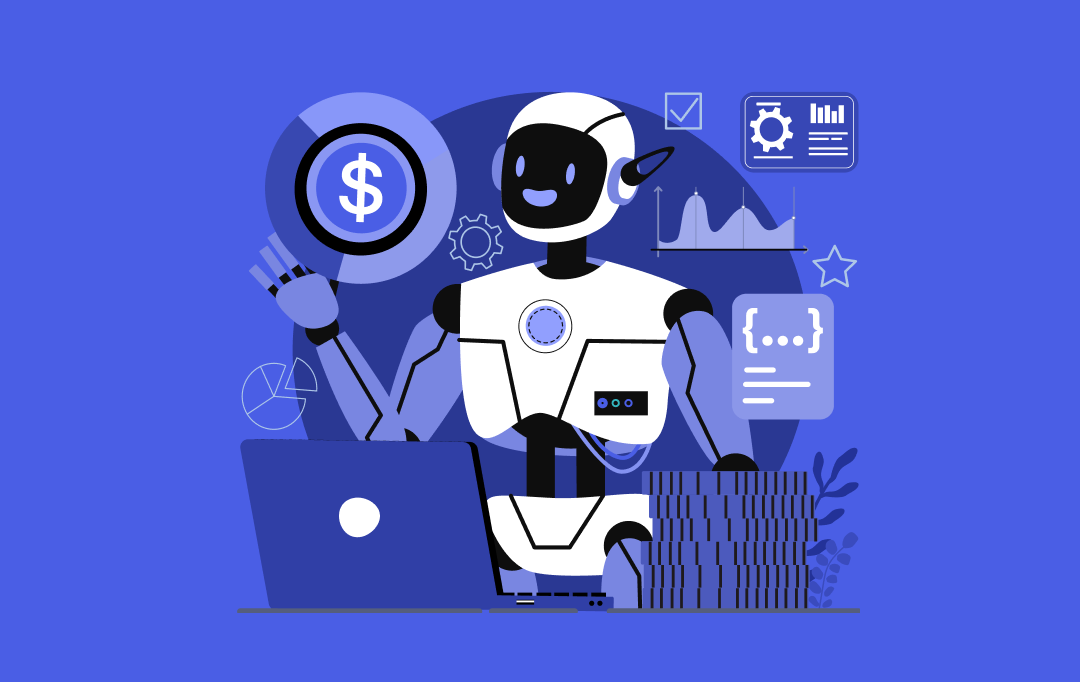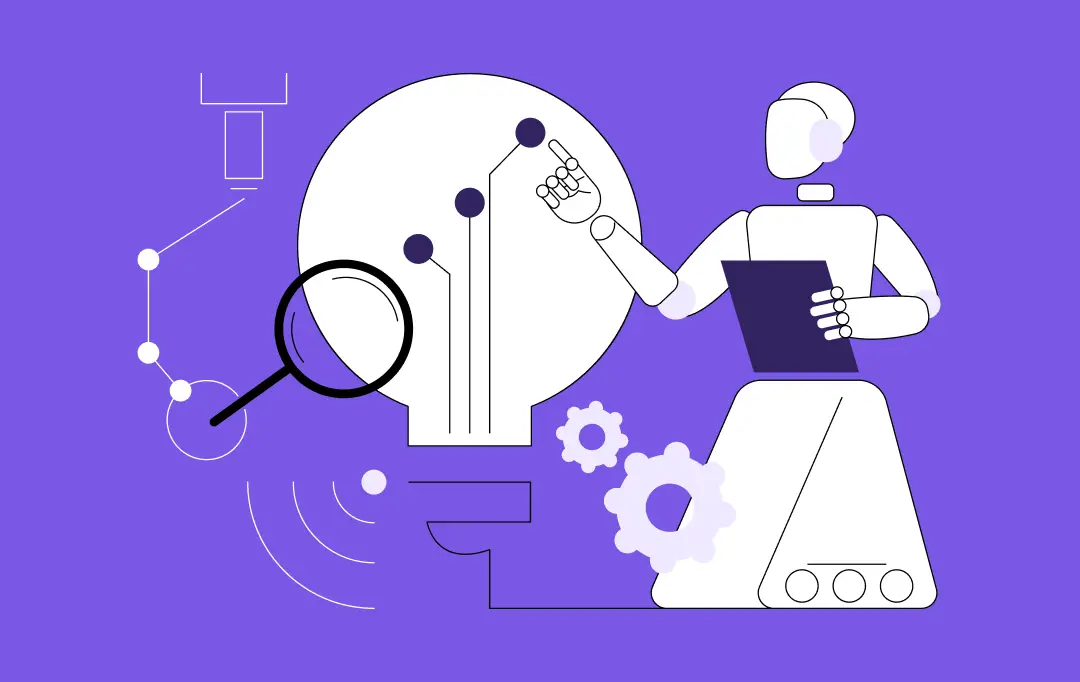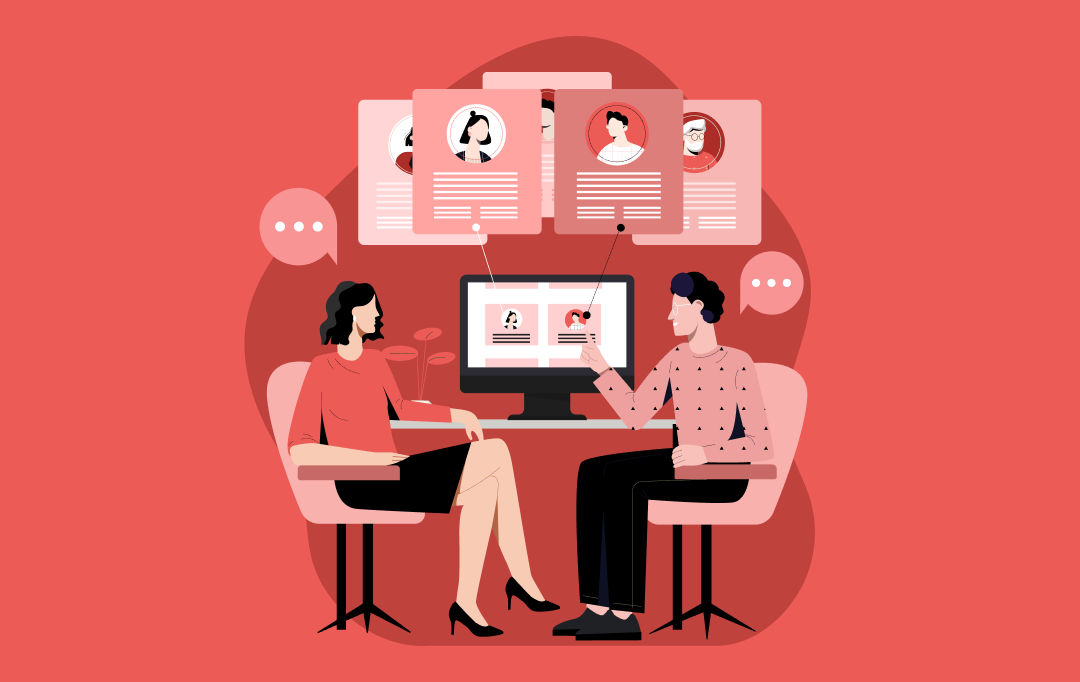- The Data Behind Food Delivery Apps: Growth and Adoption
- Key Features of Food Delivery Apps
- Customer Panel
- Restaurant Panel
- Delivery Partner Panel
- Benefits of Food Delivery Mobile App Development
- Greater Reach and Greater Revenue
- Eliminates Market Entry Barriers
- Unmatched Convenience to the Customers
- One-on-One User Experience
- Increased User Engagement
- Predictive Analytics
- Architecting Your Vision: Types of Food Delivery App Development
- The Aggregator Model: The Digital Marketplace
- The Order and Delivery Model: The Logistics Powerhouse
- The Fully Integrated Model: The End-to-End Control
- Cloud Kitchens (Ghost Kitchens) Model: The Culinary Hub
- Direct-to-Consumer (D2C) Model: The Brand’s Own Channel
- Subscription-Based Delivery Services: Curated Convenience
- Hyper-Local Partnerships & Community Commerce
- Emerging Trends in Food Delivery App Development
- AI-Driven Intelligence
- Automation and Robotics for the Next Generation of Delivery
- Cloud Dining and Virtual Restaurants
- Voice-Activated and 3D Ordering
- Sustainability, Health, and Ethical Practices
- Beyond Meals: Fast Business and Multi-Category Delivery
- How to Build a Food Delivery App: Step-by-Step Guide
- Market Research & Validation
- Define Your Business Model
- Plan Features & Functionality (MVP First)
- Select the Right Tech Stack
- UI/UX Design & Prototyping
- Development & Integration
- Testing & Quality Assurance
- Launch & Marketing
- Post-Launch Support & Iteration
- Food Delivery App Development Cost & Timeline
- Journeys of Triumph: Appinventiv’s Food Delivery App Development Case Studies
- KFC Case Study
- Pizza Hut Case Study
- Domino’s Case Study
- Challenges in Food Delivery App Development and Solutions to Overcome Those
- Fierce Market Competition
- Providing a Smooth User Interface
- Risks of Fraud and Securing Payments
- Scaling Infrastructure with Growth
- Monetization Strategies For Food Delivery Apps
- Leverage Appinventiv’s Experience to Build a Food Delivery App
- FAQs
Key takeaways:
- The global food delivery market is projected to surpass $254 billion by 2030, highlighting massive opportunities for app-driven food ordering businesses.
- The cost of food delivery app development ranges from $30,000 to $ 300,000 or more, depending on several key factors.
- Essential features for success include real-time order tracking, multiple payment options, AI-powered recommendations, and customer feedback systems.
- The integration of AI, ML, and other emerging technologies into food delivery apps enhances customer experiences.
The world’s appetite for digital convenience is simply insatiable. What began as a handy way to get dinner has quickly transformed into an undeniable force in how we live and eat.
Just think about it: the global online food delivery market is projected to reach the valuation of $254 billion by 2030 (Source: GVR). That’s not just growth; that’s a revolution happening right before our eyes, reshaping our dining habits and making app-driven food ordering a daily norm for so many.
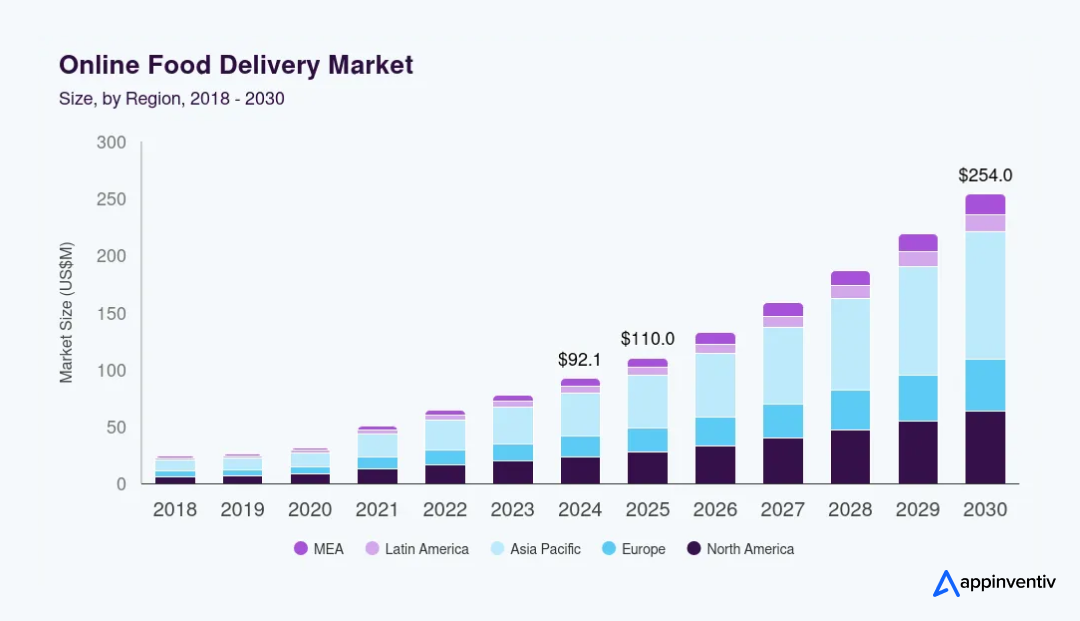
A variety of factors contribute to this accelerated growth, including the convenience of delivery to the doorstep and increased demand for diverse cuisines and healthier choices. There has also been increased adoption due to smartphone penetration, secure digital payments, and enhanced logistics networks.
It is driven not just by consumer convenience, but also by structural changes, including urban migration, dual-income families, and unfettered venture capital support. However, collaboration with cloud kitchens and innovative breakthroughs in predictive logistics are also transforming the supply chain, and ordering food via apps has become a common practice every day. These forces combined are driving food delivery apps out of the comfort zone and into a necessity of the contemporary dining experience.
The message here is crystal clear: there’s an immense opportunity and significant money to be made. Whether you’re dreaming of a customized food delivery app development solution for your beloved restaurant, looking to dive into the booming grocery delivery scene, or envisioning a broad food ordering mobile app development platform that rivals the big names, you’re standing at the edge of something truly big.
Stick with us, and we’ll show you the intricate path to building your own impactful presence in this digital culinary world. In this blog, we will give you a sneak peek into the growing dominance of food delivery mobile app development, the statistical facts, cost, process, features, and case studies of food delivery businesses.
Turn this statistic into an opportunity with a custom-built app that keeps your business at the center of the market
The Data Behind Food Delivery Apps: Growth and Adoption
The food delivery sector has seen rapid expansion, powered by changing lifestyles and digital adoption. Understanding the numbers helps highlight not only how far the industry has come but also where it is heading. The following data points outline growth patterns, user behavior, and adoption trends that define this market today.
- The food delivery app sector is on track to reach $213 billion by 2030 (Source: BusinessofApps)
- Uber Eats ranks as the most popular option worldwide, though Delivery Hero actually has more users when you count all their platforms together.
- DoorDash owns the US market with over 65% share.
- In China, Meituan ranks first, followed by Ele.me.
- For 2024 downloads, Uber Eats came out on top, with Meituan taking second place.
- Of all restaurant operators, 60% have noted increased sales with the introduction of delivery services. (Source: Market.us)
- Millennials have a preference for convenient delivery or takeout, as 59% of their restaurant orders fall into this category.
Key Features of Food Delivery Apps
An effective food delivery application operates three harmonized panels, including Customer, Restaurant, and Delivery Partner. The panels have features that suit their users, and hence they operate well, engage, and grow well. Let’s have a detailed look at those.
Customer Panel
The customer panel lies in convenience and customization, as well as a hassle-free ordering process.
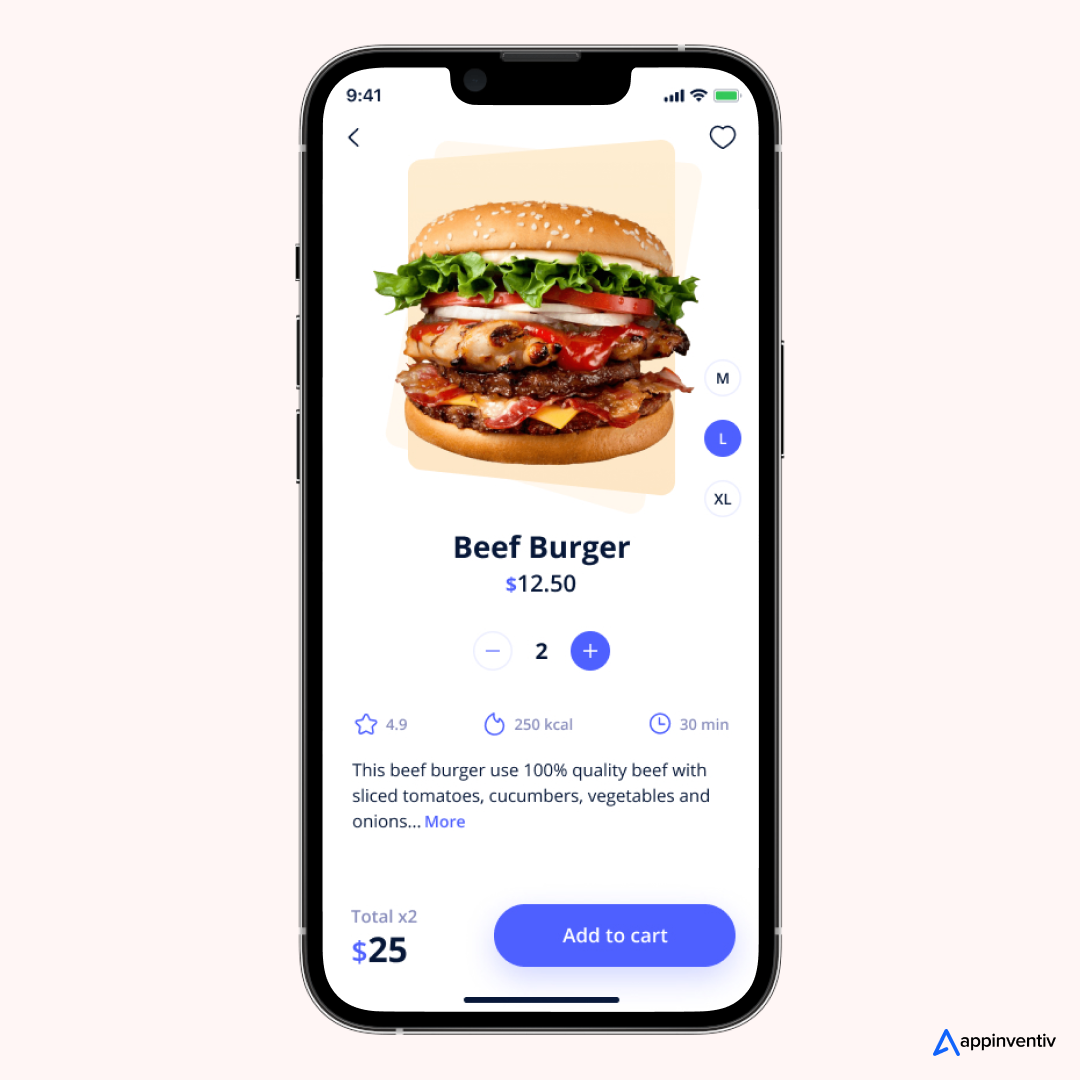
User Registration and Profiles: Register using email, phone, or social media, and save preferences to order quickly.
Menu Browsing and Search Filters: Browse cuisine, diet, price, ratings, or restaurant popularity.
Order Tracking: You can track order status, from preparation to delivery, in real time.
Multiple Payment Options: Support for cards, wallets, UPI, net banking, and cash-on-delivery.
Ratings and Reviews: Make restaurants and dishes rateable.
Favorites and Wishlist: Save favorite restaurants or dishes so that they can be accessed faster.
Promotions and Coupons: Use discounts, promotional codes, or loyalty.
Order History: View the history of previous orders to reorder or to view.
Push Notifications: Receive notifications about new offers, order status updates, and new restaurants.
In-App Chat/Support: Chat directly with the customer support or the delivery partner.
Estimated Delivery Time: Show ETA of individual orders to set expectations.
Personalized Recommendations: AI-generated recommendations, depending on user behavior and interests.
Restaurant Panel
The panel enables restaurant vendors to handle orders, menus, and performance metrics effectively.
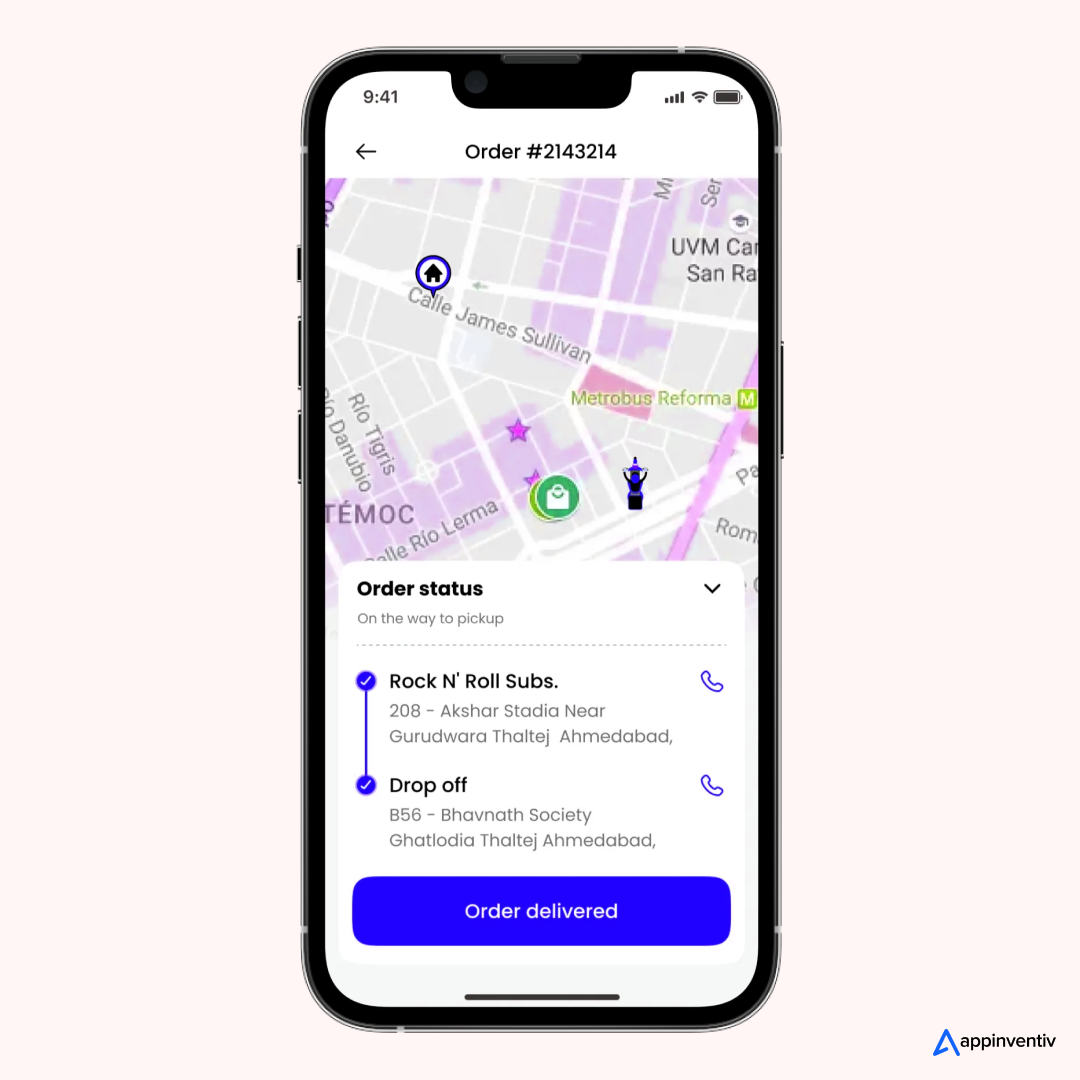
Order Management: Accept, reject, or modify orders in real-time.
Menu and Inventory Edits: Add, delete, or edit dishes and keep track of their availability.
Analytics and Reports: Information on the revenues, busy times, and best sellers.
Promotions and Discounts: Runs are promotions to get and keep customers.
New Orders Notifications: Immediate notifications about the orders received.
Check Order Status: Mark an order as prepared, ready to pick up, or delayed.
POS Integration: Interact with the current point-of-sale systems in order to operate smoothly.
Access to Customer Feedback: Read customer ratings and provide comments.
Multi-Location Manager: Manage multiple restaurant outlets from a single dashboard.
Delivery Partner Panel
The panel on the delivery partners makes sure that the deliveries are delivered in time, the routes are efficient, and earnings managed.
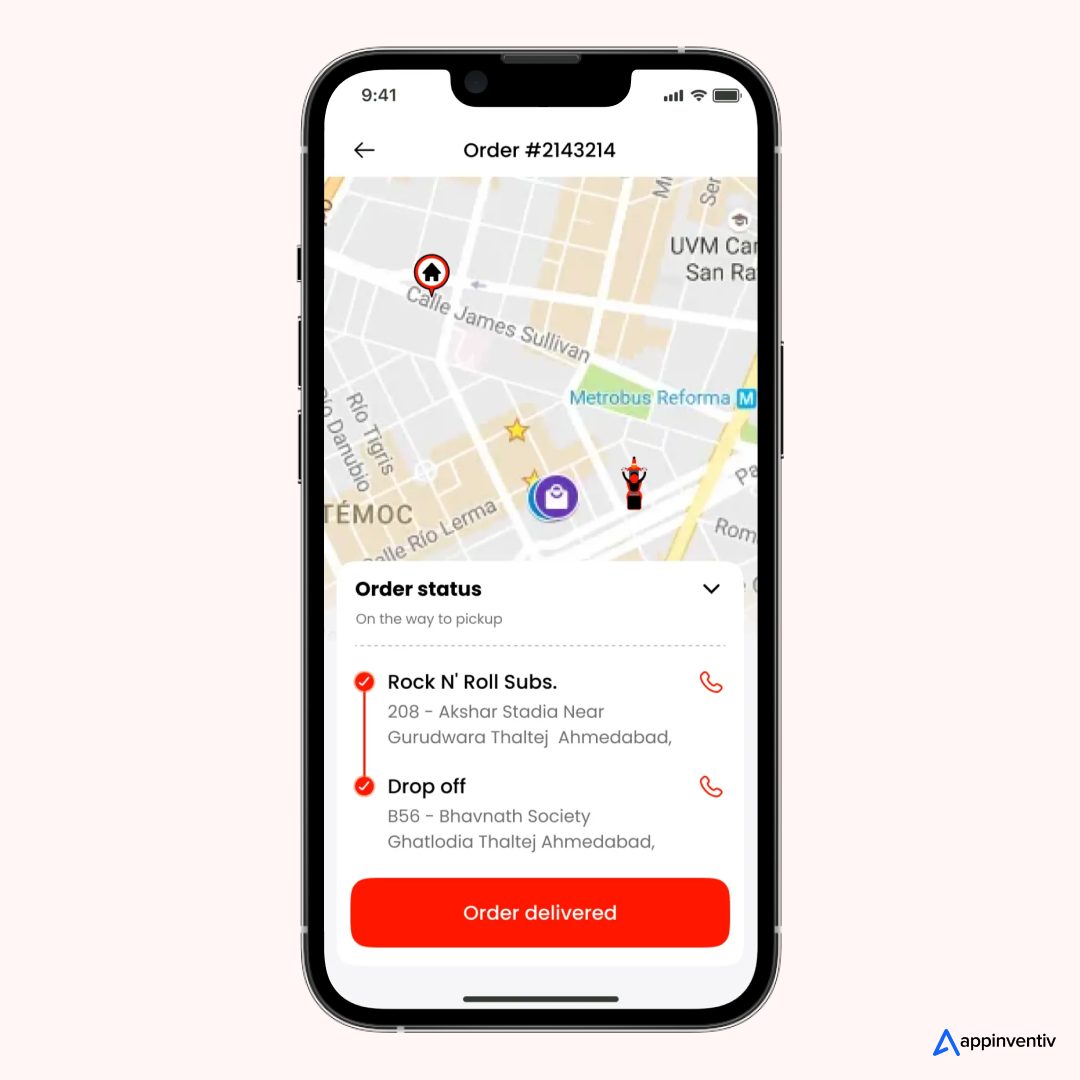
Real-Time Order Assignment: Get new orders in real-time, depending on a location and availability.
GPS Navigation: Built-in maps to follow proper, efficient directions.
Route Optimization: Recommends the shortest routes to minimize delivery time.
Status Updates: Mark updates picked up, in transit, or delivered.
Earnings Dashboard: Monitor daily, weekly, or monthly revenue.
Incentives and Bonuses: Keep track of performance rewards or promotions.
Availability Management: Establish work hours and accept/ reject orders respectively.
In-App Communication: Reach out to customers or support to help coordinate delivery.
Delivery History: View the history of previous deliveries and performance.
Benefits of Food Delivery Mobile App Development
The food business is expanding rapidly, and an entrepreneur may have numerous reasons to invest in building online food delivery apps and become a significant player in this lucrative industry. The following are some of the reasons why tapping into the potential of food delivery apps can be extremely lucrative to businesses:
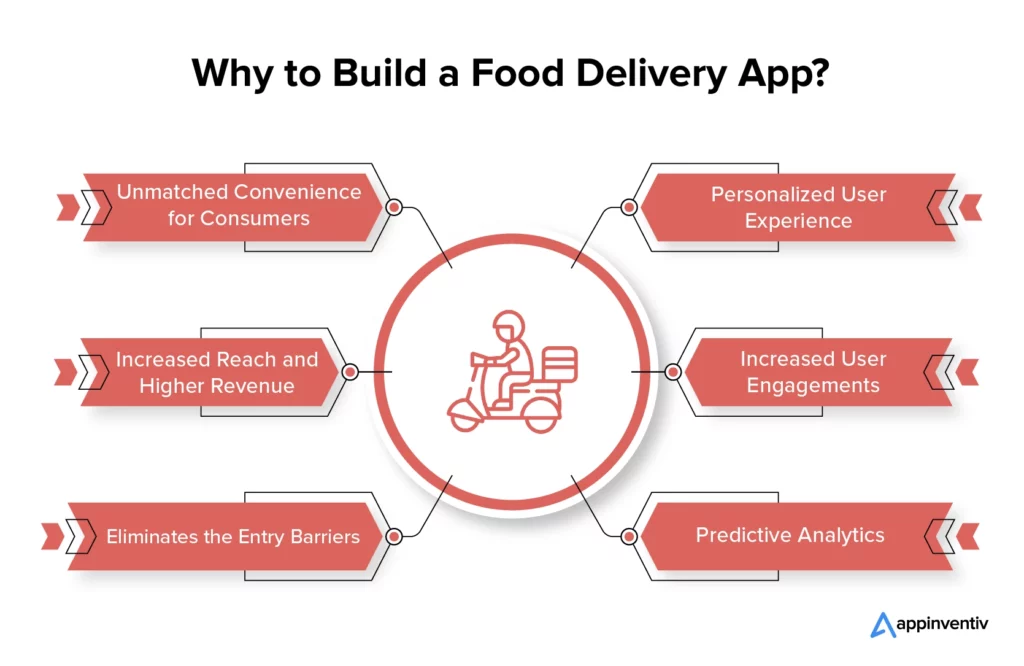
Greater Reach and Greater Revenue
In the case of the restaurant industry, mobile app utilization will translate into accessing a wider range of consumers located all across the globe, meeting the demands of potential users who would have otherwise not discovered their product/service. It is a long reach that can lead to a massive sale and a rise in revenue, which will play a role in the overall growth and success of the restaurant.
DoorDash is a notable example of an international food delivery company, serving the culinary needs of its customers in Canada, Australia, and the US.
Eliminates Market Entry Barriers
Food delivery is also reputable in terms of low barriers to entry, which encourages a highly welcoming environment for new startups and new entrants. Unlike in conventional businesses, where large start-up capital and complex systems are needed, the on-demand food delivery solutions enable aspiring entrepreneurs to begin their food delivery venture using relatively small investments.
Unmatched Convenience to the Customers
Mobile apps offer unprecedented convenience to food lovers by making various food items from various regions accessible at their fingertips. In a matter of a few taps on their smartphones, users are able to easily view various menus, make orders, and monitor their deliveries in real time. This simplified system removes the necessity of using the old-fashioned techniques, such as phone calls or a physical menu, and it is extremely convenient to the current busy lifestyle.
One-on-One User Experience
Mobile applications facilitate individual user experience, which lets the business customize its products according to user preferences and actions. As data analytics and artificial intelligence integration develop in the restaurant sector, the business will have the opportunity to forecast customer preferences, propose customized menus, and even provide some special discounts or coupons. Such personalization enhances the user’s experience and fosters brand loyalty.
Increased User Engagement
A food delivery app with multiple functions will enable restaurants to engage in active interaction with their customers through push notifications, messages, emails, or even chatbots. This assists the businesses in making the users know about their latest offers, loyalty programs, and lucrative deals and discounts to enable them to remain engaged with the offers you have.
Predictive Analytics
The restaurant industry is one of the fields where mobile apps can offer meaningful data analytics based on AI. These insights can help businesses make decisions as they can monitor the trend of orders over time in order to understand the peak periods. Additionally, mobile apps streamline the ordering and delivery process, minimizing the likelihood of errors and ensuring operational efficiency.
These are among the most prevalent advantages of the food delivery mobile app development. With the growing technological changes, companies that choose to use mobile app solutions are destined to gain more transformational benefits and continued success in the competitive world of the food delivery business.
Related Article: A Comprehensive Guide on Using Predictive Analytics for Mobile Apps
Architecting Your Vision: Types of Food Delivery App Development
Before embarking on on-demand food delivery app development, a crucial strategic decision lies in defining the underlying business model. Each model presents unique advantages and operational considerations, dictating the scope and complexity of your application. Understanding these archetypes is key to designing a solution that aligns perfectly with your market aspirations.
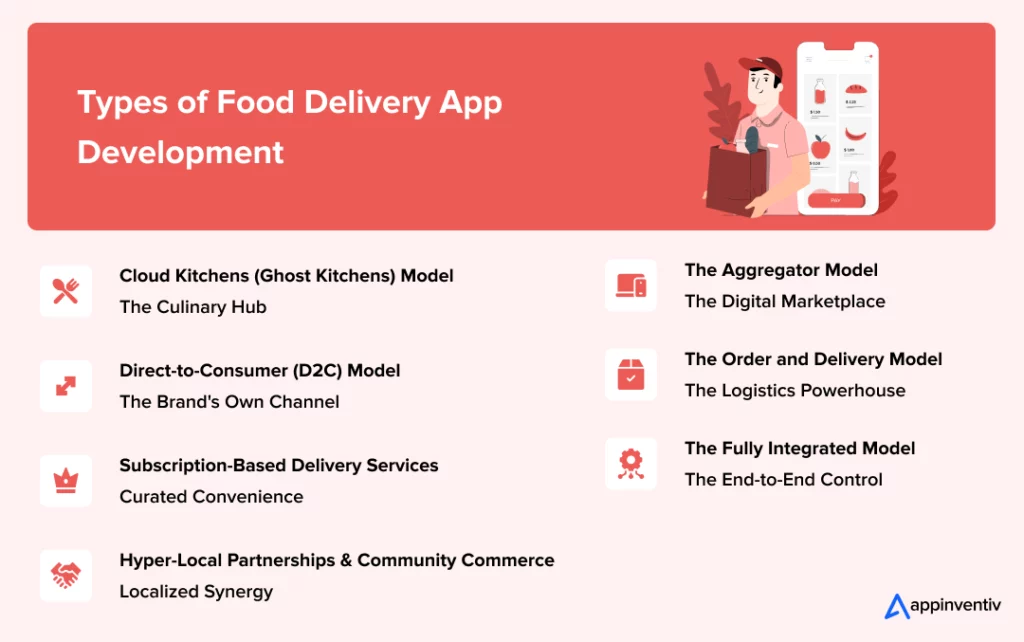
The Aggregator Model: The Digital Marketplace
It is arguably the oldest example of this model, and its most notable representatives are such giants as Uber Eats and Zomato. The application is a digital marketplace that is centralized, where the menu of many different restaurants is available. Order placement and payment are done through your platform, and in many cases, preparation of food and even delivery are done by restaurants.
Revenue Streams: The major sources of revenue include restaurant commissions, customer delivery fees, and advertising.
Best Suited: For startups that need to enter the market fast with a low initial overhead to consider, and are interested in developing a large network of restaurants and users.
The Order and Delivery Model: The Logistics Powerhouse
In this case, it is your platform that does the order aggregation and all the delivery logistics. The food is made at restaurants, and the delivery of food to the door of the customer is made by a dedicated fleet of delivery workers (or third-party logistics partners).
Revenue Streams: Delivery, Restaurant Commissions, and possible surge pricing.
Best Suited: Businesses that want to have a higher level of control over the customer experience, deliveries that are faster and more reliable, and possibly have specific geographic targets with high levels of demand for deliveries.
The Fully Integrated Model: The End-to-End Control
It is the most control-oriented model, with the app owner controlling all key factors, including food preparation (which is usually done through their own so-called cloud kitchens or virtual restaurants) and delivery. It has no brick-and-mortar shop; everything is optimized to be delivered.
Revenue Streams: Direct food delivery charges.
Best Suited: Entrepreneurs wishing to brand their own virtual-restaurant names, explore new cuisines, or maximize efficiency and cost without the complications of a more traditional restaurant. This model is very similar to the Cloud Kitchen.
Cloud Kitchens (Ghost Kitchens) Model: The Culinary Hub
The contemporary version of the built-in model, cloud kitchens are commercial cooking spaces designed with the specific aim of operations focused solely on delivery purposes. They do not have a dining place and are only interested in delivering online orders. One cloud kitchen can also accommodate multiple virtual restaurant brands, maximizing kitchen capacity and resources.
Revenue Streams: The direct sales of food, which are usually optimized by reducing overheads.
Best Suited: Restaurants that already offer delivery services but want to expand their online presence, or new food businesses looking to enter the market at a cost-efficient price.
Direct-to-Consumer (D2C) Model: The Brand’s Own Channel
The restaurants or food businesses, in this model, create their own branded mobile app development solution for food delivery, where they engage directly with their customers and avoid third-party aggregators.
Revenue Streams: Direct food sales, reward programs.
Best Suited: Established restaurant chains or local restaurants with a strong customer base and aiming to build stronger customer relationships, minimize the commissions that are paid to aggregators, and gain a better understanding of their clients. This will enable more control of branding and the customer experience.
Subscription-Based Delivery Services: Curated Convenience
Users are charged a recurring payment as a subscription fee to get perks such as free or discounted shipping, priority access to specific restaurants, or customized meal plans. This model is concerned with creating long-term customer loyalty and predictable revenue.
Revenue Streams: Subscription fees, which are augmented with individual order payments.
Best Suited: Companies that need to build a very loyal customer base and offer high-quality and value-added services.
Hyper-Local Partnerships & Community Commerce
These services aim to connect customers with restaurants and food sellers in a highly restricted geographical area, focusing on fast service and community benefits. These usually include close collaborations with local businesses and delivery staff.
Revenue Streams: Commissions, delivery fees, and possibly local advertising.
Best Suited: A business that wants to use the spirit of community and its businesses, as well as provide very fast delivery to its customers within a specific neighborhood.
You may like reading: Top 10 Restaurant Business Ideas You Can’t Ignore in 2025
Emerging Trends in Food Delivery App Development
The on-demand food delivery app development is rapidly developing in a way never seen before. The apps of tomorrow are being dictated by rapid technological innovation, changing consumer expectations, and new business models. It is imperative to understand new trends in order to be ahead in this competitive environment.
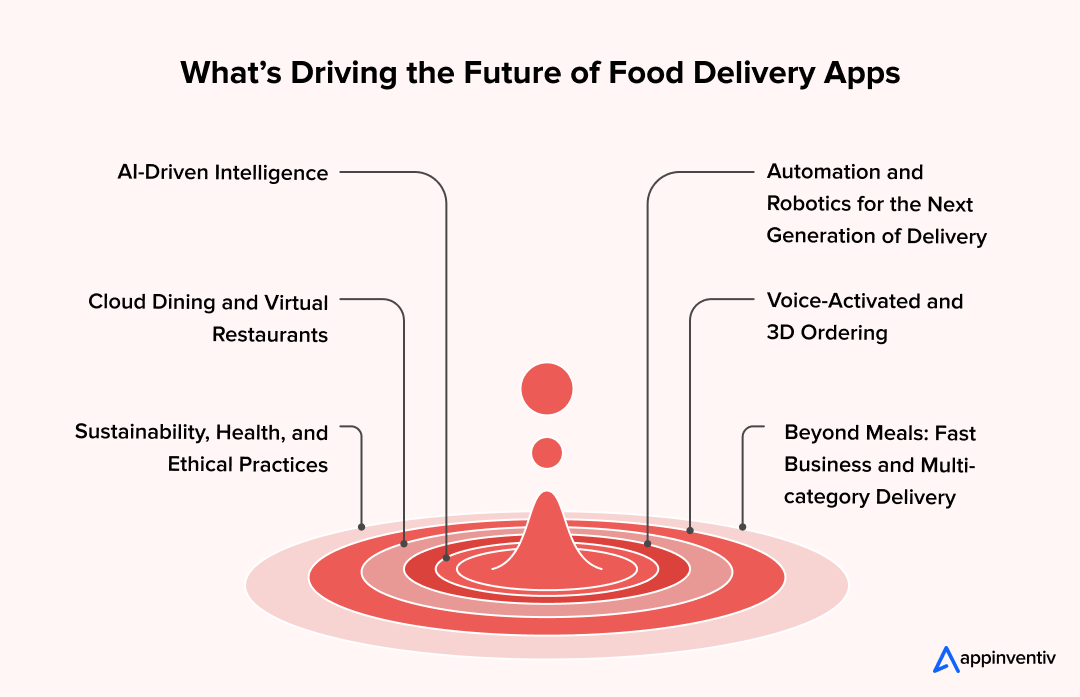
AI-Driven Intelligence
AI is undoubtedly the driving force behind food delivery businesses. The operations are being optimized by predictive ordering, dynamic pricing, and AI-based kitchen management. Along with sophisticated analytics, AI in food delivery can allow platforms to predict demand, target customers with personalized promotions, and assist restaurants with smarter inventory management.
Automation and Robotics for the Next Generation of Delivery
Last-mile delivery is being changed by automation. Robotic deliveries, autonomous vehicles, and delivery drones are becoming more and more feasible, and cost reduction and shortening the delivery time are achieved. Intelligent warehouses and AI-driven kitchens also enhance operational efficiency, enabling the expansion of high-speed, scalable services in urban areas.
Cloud Dining and Virtual Restaurants
Online restaurants and cloud kitchens are changing the process of food preparation and delivery. By eliminating the need to have physical storefronts, these facilities enable a quick time to experiment with new cuisines, less overhead, and can easily blend in with app platforms. Local and hyperlocal personalization ensures that customers are aware of trending dishes and restaurants in the city.
Also Read: How to build an online cloud kitchen platform like Kitopi?
Voice-Activated and 3D Ordering
AR is redefining the food and beverage industry through immersive restaurant experiences, and allows users to preview food in 3D or take virtual tours through restaurants. Voice-activated ordering can be facilitated by smart devices and IoT with connected kitchen appliances to make ordering more convenient, quicker, and easier.
Sustainability, Health, and Ethical Practices
The new food delivery services in the future will focus on wellness and sustainability. Individualized food suggestions, sustainable packaging, carbon-neutral delivery, and AI-based food waste management are emerging as key differentiators, aligning with the ethical consumer demands.
Beyond Meals: Fast Business and Multi-Category Delivery
Food delivery companies are venturing into the quick commerce business, where they deliver groceries, pharmaceuticals, and household goods. The use of blockchain technologies and smart delivery solutions (contactless, temperature-controlled packages, and IoT tracking) can lead to a higher level of transparency, efficiency, and trust.
How to Build a Food Delivery App: Step-by-Step Guide
There is no better way to tap into the flourishing food market than to make a feature-rich application for your business. However, making an app for food delivery is a complex and challenging process, requiring professional expertise and experience in building similar applications. To ensure your food ordering app development process is set up for success, follow this actionable, step-by-step process:
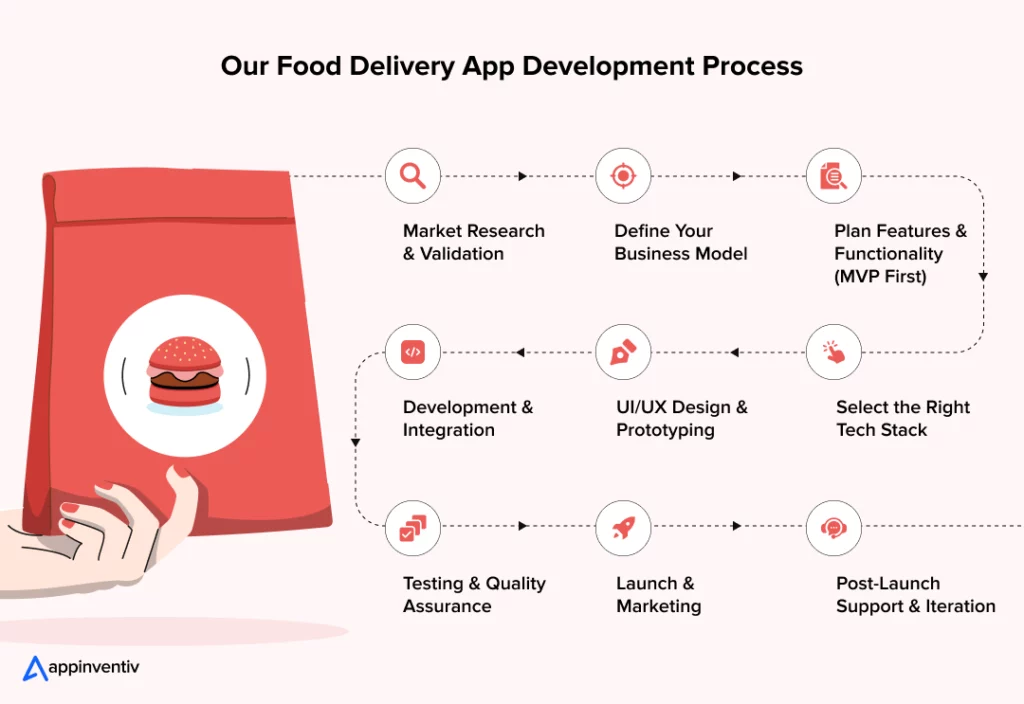
Market Research & Validation
Knowing your market and understanding your audience are crucial before investing in development. Begin by researching customer preferences, pain points, and eating behaviors via surveys and interviews. Evaluate the current competitors to know what they are doing well and what they are doing poorly.
Find something that you can do to satisfy the gap, such as offering faster service, healthier food, or local favorites. Validation will make sure that there is indeed a demand for your idea and reduce the risks in implementation.
Define Your Business Model
Depending on the business model you choose, your app will generate revenue and remain profitable in the long term. Choose the option of being an aggregator, operating both delivery and order management, or developing an ecosystem that is fully integrated.
Niche markets can also fit other models such as cloud kitchens, subscription-based services, or hyper-local deliveries. Make your decision consistent with the accessible resources, your audience, and your vision of growth. An effective business model is the basis of strategy and partnerships.
Plan Features & Functionality (MVP First)
Effective applications are a balance between usefulness and ease of use. Start by defining what each stakeholder requires, such as customers, who need to be able to browse and pay, restaurants, which require menu management, drivers, who need to be able to navigate, and administrators, who need to monitor operations.
Focus on features that are important to the MVP development, including the ability to place orders, track, and make secure payments. Initial operations with essential functions help you scrutinize the market at an early stage. Subsequently, you may introduce such complex features as loyalty programs or AI-based recommendations.
Select the Right Tech Stack
The choice of technology will define the scalability, velocity, and user experience of your app. Select tools and structures that cater to both iOS and Android in order to reach as many people as possible. Consider security provisions against such sensitive data as payments or addresses.
It is also crucial to consider scalability through cloud solutions and integration via APIs. The right stack will ensure your app runs smoothly, even during high traffic. This type of future-proofing will save significant cost and rework in the future.
UI/UX Design & Prototyping
In a saturated market, the design should be smooth in order to be retained. Design wireframes and prototypes to get a visualization of how the app will flow and to obtain feedback early. Pay attention to logical navigation, the clean design, and usability by everyone.
Make sure the branding aspects, such as colors, fonts, and icons, are in line with your identity. Perform usability tests to determine the pain points prior to development. The proper design development breeds confidence and customer loyalty.
Development & Integration
Development should start with the MVP and grow to additional features. Agile methodologies are very functional and allow faster iterations and real-time feedback. Add necessary APIs to maps, payment gateways, and push notifications to enhance functionality.
Develop back-end software to process orders, user information, and instant communication. Through the coordination of the developers, the designers, and the QA teams, there will be smoother moving forward. Formal methodology makes development streamlined and flexible.
Testing & Quality Assurance
Quality assurance ensures reliability and satisfaction for the user. Conduct extensive testing, which includes both functionality and usability testing, as well as performance evaluation under various conditions. Check security vulnerabilities since the information about the personal and payment is sensitive.
Integration test is essential in ensuring the APIs, databases, and front-end elements are well integrated. Bug fixing at the initial stages saves expensive losses in the future. An app with no errors and polished is unique in the competitive market.
Launch & Marketing
When you have an app, you need to launch it in a strategic manner to get maximum visibility. Post on app stores and optimize the listing with descriptive and visual content. Arrange specific marketing campaigns by utilizing digital advertising, collaborating with influencers, or involving the local restaurant.
Use leverage promotions like discounts and referral bonuses to get first users. Keep a close eye on downloads and activity in the first few weeks. Momentum is built by a good launch of the long-term growth.
Post-Launch Support & Iteration
Developing a food delivery app is a continuous task and not a single course of events. Receive feedback directly from users and monitor app analytics to identify areas for improvement. Put out frequent updates to introduce features, enhance performance, and fix security risks. Remain user-receptive in order to remain loyal within a competitive environment. Long-term assistance implies that your application will be developed according to market trends. Value delivery and adaptability a key to long-term success.
For an in-depth understanding of how to create a food delivery app or step into this thriving venture, delve into our comprehensive guide on how to start your own food delivery business.
Food Delivery App Development Cost & Timeline
When planning to make a food delivery app like KFC, Pizza Hut, or Domino’s, people often contemplate the app development cost. While the cost to build the latest food delivery app is one of the most crucial considerations, it is challenging to quote an exact amount as the Pizza Hut, Domino’s, or KFC food delivery app development cost significantly varies depending on multiple factors.
Some of the most important factors that affect the custom food delivery application development cost are:
- The intricacy and sophistication of the app’s design, level, features, and functionalities.
- The number of third-party plugins available in the app to improve user engagement.
- The targeted platform (Android, iOS, or cross-platform) on which the app will run.
- Intensity and frequency of regular maintenance and updates required to ensure the apt app performance.
- The geographic location of the chosen mobile app development company.
On average, KFC, Pizza Hut, or Domino’s food delivery app development costs range between $30,000 and $300,000 or more, depending on the aforementioned cost-influencing factors. Here is a brief table outlining food delivery app development cost and timeline:
| App Development Type | Estimated Cost | Development Timeline |
|---|---|---|
| Basic Food Delivery App | $30,000 – $60,000 | 3 – 6 months |
| Mid-Range Food Delivery App | $60,000 – $150,000 | 6 – 9 months |
| Advanced Food Delivery App | $150,000 – $300,000+ | 9 – 12 months |
| Enterprise-Level App | $300,000+ | 12 months+ |
Journeys of Triumph: Appinventiv’s Food Delivery App Development Case Studies
We, as a leading IT company, have established ourselves as a frontrunner in app development, particularly in the food delivery sector. With a proven track record and a commitment to innovation, we have successfully crafted innovative solutions for global businesses that elevate user experiences and drive growth.
Our approach involves a meticulous understanding of client needs, leveraging cutting-edge technologies, using the best security measures, and delivering apps that stand out in the competitive market.
Let us elucidate the case studies of three business giants in the food industry and witness how we turned their distinctive vision into an enticing reality through our intuitive and agile online food ordering app development process.
KFC Case Study
KFC, a leading fast-food company with a global presence in 150+ countries, operates under Americana Group in the Middle East and is the world’s second-largest restaurant chain.
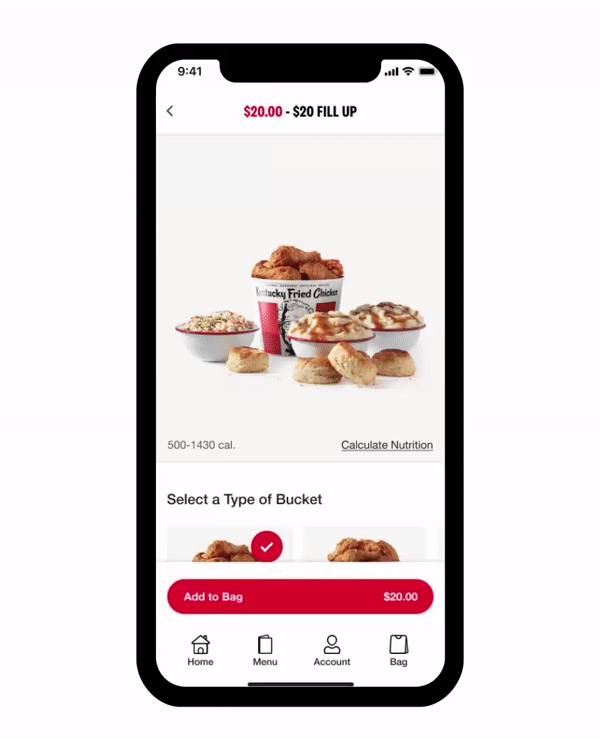
Challenges Faced by KFC
- Nearly 90% of KFC’s total orders were coming through aggregator apps, raising concerns about the brand’s dependency on third-party platforms.
- With a significant portion of orders funneled through aggregator apps, KFC faced increased operational costs and the risk of potential damage to the brand’s digital image.
- The challenges escalated when KFC started receiving negative reviews on its own platform, primarily related to a poor user experience.
Appinventiv’s Strategic Solution
KFC, facing such challenges in the Middle East, turned to Appinventiv for a comprehensive solution with a vision to develop seven KFC mobile applications within a year. We took these challenges as an opportunity to prove our expertise by building a robust direct-to-consumer digital channel for KFC.
We developed seven custom food delivery apps in the Middle East across – the UAE, KSA, Kuwait, Egypt, Qatar, Bahrain, and Oman, ensuring a personalized user experience for specific regions and demographics.
Results and Impact
The development and launch of seven KFC mobile applications within the stipulated timeframe helped KFC witness a transformative shift in its digital delivery channel, leading to significant positive outcomes:
- 22% increase in conversion rate
- 4.5 average rating on the Google Play Store and App Store
- Over 50% of the total orders coming through the app
- Over 60% increase in repeat purchases across channels
- Highest customer lifetime value across all order modes
- Reduced resilience on aggregator apps from 90% to 50%
- 30,000+ orders filled through the app per day.
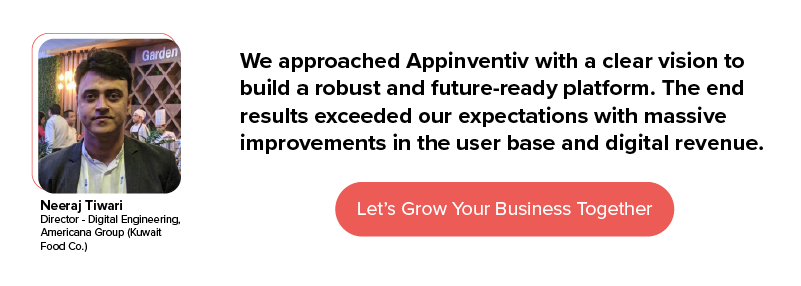
Pizza Hut Case Study
Pizza Hut, one of the largest multinational restaurant chains, operates 17,639 restaurants worldwide as of 2020.
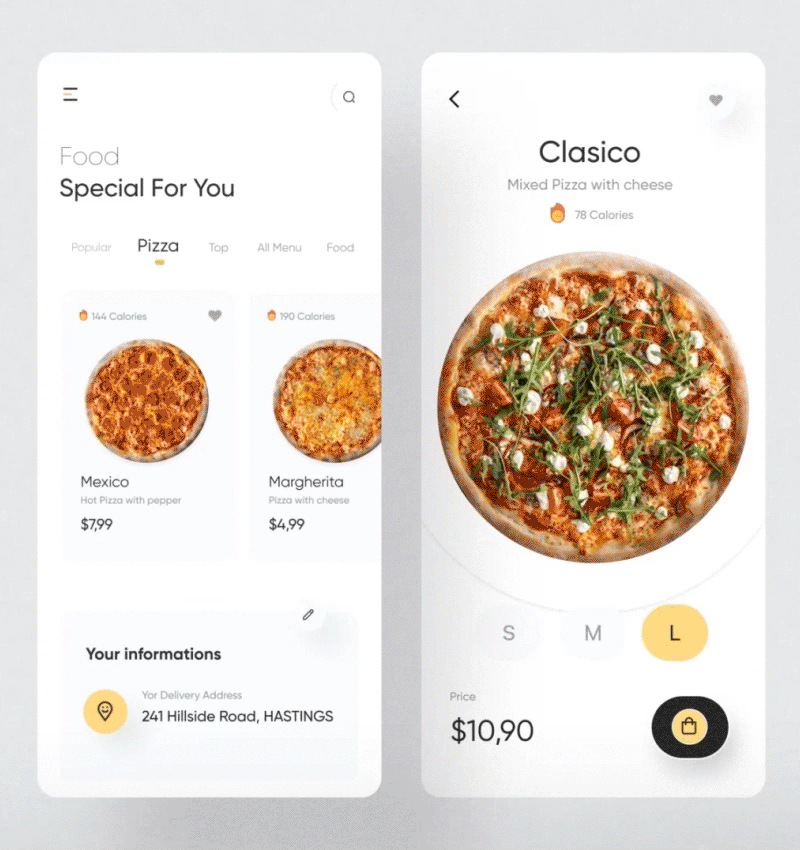
Challenges Faced by Pizza Hut
- Pizza Hut faced challenges in maintaining a strong digital presence. Their existing app struggled to keep pace with modern standards, hindering its performance.
- The app lacked an extensible and scalable architecture, limiting its ability to adapt to the evolving needs of today’s digital age.
- Customers encountered difficulties navigating the app, placing orders, and enjoying a seamless interaction with Pizza Hut’s offerings, leading to poor user experience.
Appinventiv’s Strategic Solution
Our team of 1200+ tech evangelists recognized the need for a comprehensive overhaul of Pizza Hut’s app. Thus, we conducted thorough research to understand the unique needs of Pizza Hut’s target audience and created a user-friendly design that resonated with users, ensuring a more personalized and engaging experience.
To meet industry standards, we leveraged the latest tools and technologies to enhance the app’s functionality and keep it at the forefront of trends.
Results and Impact
The redesigned app provided Pizza Hut with a revitalized digital presence, aligning with industry standards, meeting users’ expectations, and elevating the brand’s image in the digital space, which resulted in:
- 50K app downloads
- 30% increase in conversion rates
- 7 seconds increase in screen transition time
- Improved customer engagement and business growth
- Increased user interactions and order placements
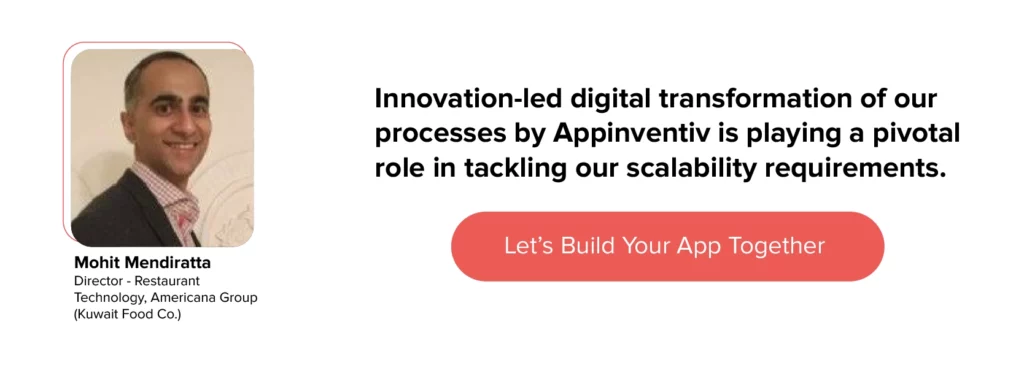
Domino’s Case Study
Domino’s is a well-recognized powerhouse of pizza delivery worldwide, operating over 14,000 pizza restaurants in 85+ countries and delivering more than 1.5 million pizzas every day.
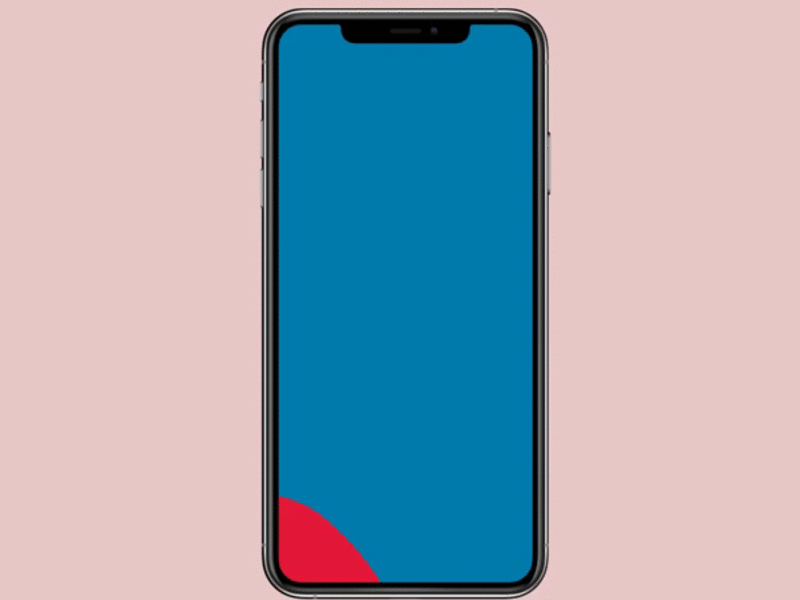
Challenges Faced by Domino’s
- Domino’s experienced a rising bounce rate on their mobile app, indicating that users were navigating away without completing orders.
- The company faced challenges in retaining customers and received negative reviews in terms of poor app experience, difficulty in placing orders, and an in-app user journey.
- One of the major concerns the brand faced was subpar UI/UX design, which led to a decrease in customers’ attention and engagement on the brand’s app.
Appinventiv’s Strategic Solution
Domino’s collaborated with us to resolve its pressing challenges and redefine its business identity in the market. We started the journey with a deep analysis of the core issues hindering the performance of Domino’s pizza delivery app. We dove deep into customers’ reviews and pinpointed the problem area that was making users’ in-app journeys complex.
We developed strategic solutions to revamp the UI/UX design, streamlining the app’s functionality, making it more efficient, and enhancing the overall user experience through our agile food ordering app development process.
Results and Impact
- The collaboration with Appinventiv facilitated the reinvention of Domino’s business image, reinforcing its position in the competitive food delivery market.
- Our refined UI/UX strategy reduced the bounce rate and increased the mobile app conversion rate by 23%.
- The UI/UX redesign contributed to a significant improvement in customer engagement. The users who were once leaving the app without placing the orders now spend time within the app to track their orders in real time.
Challenges in Food Delivery App Development and Solutions to Overcome Those
Building a food delivery app is more than just connecting restaurants with customers. It involves overcoming complex challenges in technology, logistics, and user experience. Addressing these hurdles effectively is the key to delivering a reliable and scalable platform. Let’s have a look at some of the top challenges with solutions:
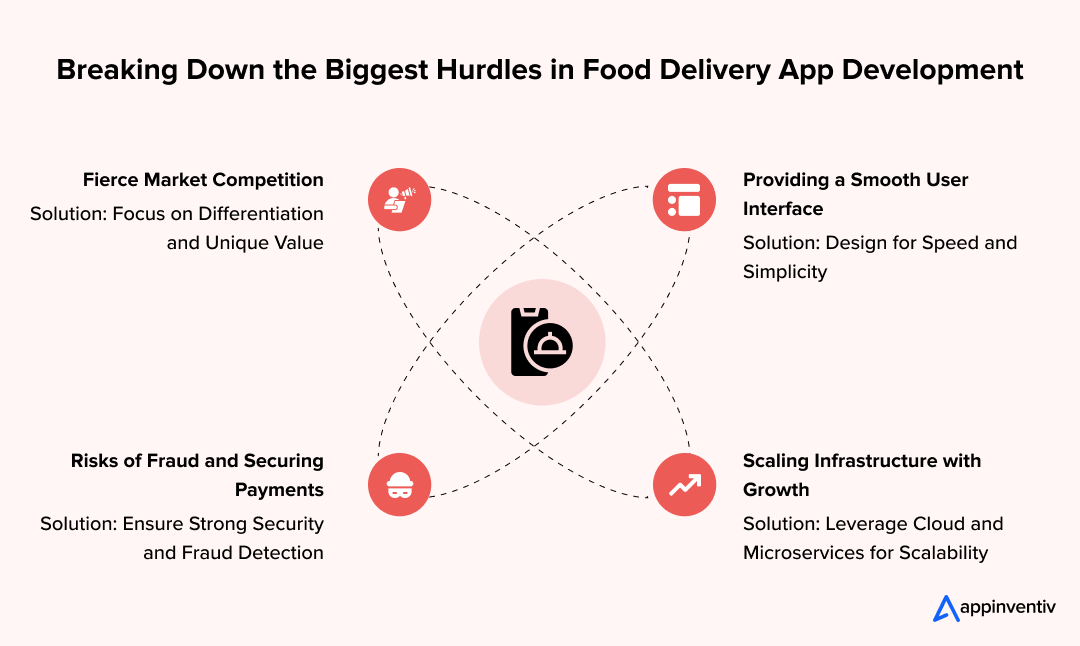
Fierce Market Competition
The food delivery market is full of established competitors and is regularly flooded with new ones. Competition in such a competitive arena can be quite overwhelming, particularly in the case of startups, which have fewer resources. In case there is no sense of identity, an app will be lost in the crowd and lose clients to more familiar platforms.
Solution: The most important thing is differentiation. The new apps must target the underserved segments or value propositions, such as providing healthier food, favoring local establishments, or using environmentally-friendly packaging. A good brand, minimalist design, and unique customer experience can serve to create awareness and devotion even within a saturated market.
Providing a Smooth User Interface
The customers want their orders to be fast, simple, and without frustration. Slow loading of the site, an unattractive interface, or inefficient navigation may send the customers away until they make an order. Customer retention is all about providing a seamless online experience, from web browsing to checkout.
Solution: Design with the customer in mind. Make the high priority to the quick loading, convenient navigation, and a few steps to checkout. The convenience is further enhanced by adding features such as AI-based meal suggestions, expanded payment methods, and real-time order tracking. The minimal, visually transparent design allows users to concentrate on what is important to them: to place an order and be sure about it.
Risks of Fraud and Securing Payments
Food delivery is a sensitive payment information that, once breached, can be very serious. A platform that cannot safeguard its information will not be trusted by customers, and regulatory compliance is an added burden of responsibility.
Solution: There should be no compromise around security. Use payment gateways, encryption protocols, and two-factor authentication that are PCI-DSS compliant to protect user information. This can be supplemented by AI-driven fraud detection to identify suspicious transactions before it is too late. The assurance of secure and smooth payments will win the confidence of the users and will lead to repeat business.
Scaling Infrastructure with Growth
What works fine for a few thousand users often buckles when demand spikes. Apps that can’t scale properly end up crashing, running slowly, or leaving customers annoyed, particularly during busy periods like holidays or when there’s a major event driving traffic.
Solution: Cloud infrastructure lets you adjust capacity based on actual demand rather than guessing ahead of time. Microservices architecture splits your workload into separate pieces, so if something breaks, it doesn’t drag everything else down. Stress testing regularly shows you where the weak points are before real users hit them. The real goal of scalability isn’t just accommodating more people; it’s ensuring your service remains reliable when it matters most.
Ensure your food delivery app delivers performance, reliability, and user satisfaction from day one
Monetization Strategies For Food Delivery Apps
There are several sources of revenue for a food delivery application. Selecting the combination to use relies on market positioning, users, and partnerships. The most prevalent app monetization practices are:
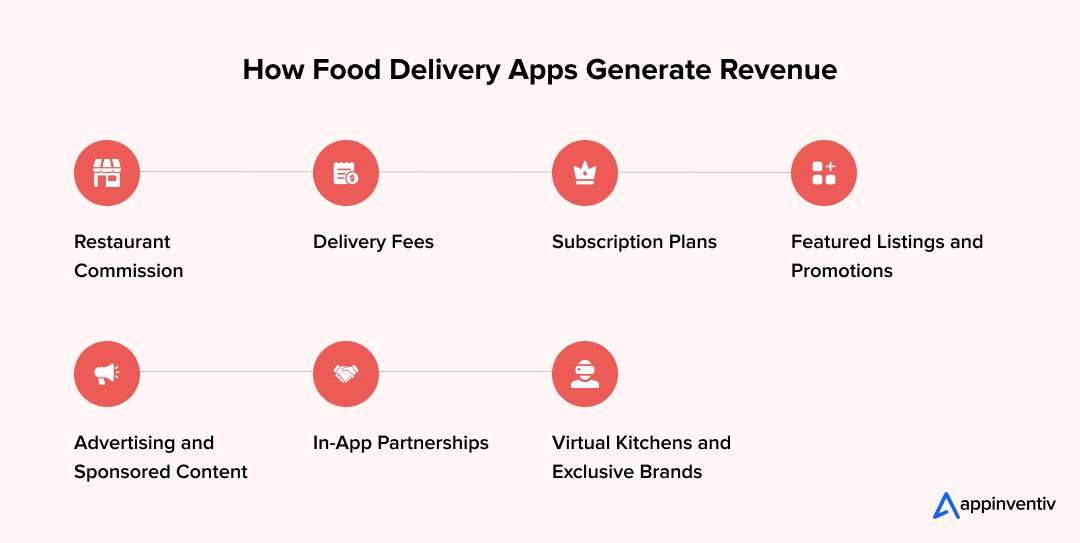
Restaurant Commission: The most popular option is one that commissions restaurants on every order placed through the app. This may be a set percentage or percentage level according to order volume. It motivates the platform to generate more orders and ensures restaurants only pay for actual sales.
Delivery Fees: The other common practice is to charge customers a delivery fee on every order. Depending on the distance, size of the order, or peak hours, fees may vary. Others also have free delivery offers as part of an effort to build new users or high-value orders.
Subscription Plans: The subscription models give a stable revenue and also value to customers. As an example, a free delivery, priority support, or exclusive discounts can be listed in monthly plans. In the case of frequent users, the savings will be achieved, and the app will guarantee a stable income.
Featured Listings and Promotions: Restaurants have the option of paying to be featured at the top of search results, featured lists, or even as part of a promotion banner. This exposes restaurants more and generates another source of revenue for the app.
Advertising and Sponsored Content: In-app advertising, sponsored dishes, or local partner promotions can serve as an additional source of income. Ads that are well placed will guarantee revenue without annoying the user.
In-App Partnerships: The collaboration with the beverage brands, dessert brands, or grocery suppliers can be the source of revenue through co-promotion or cross-selling. Users can easily make additions to their order, and the app will receive a commission.
Virtual Kitchens and Exclusive Brands: There are platforms that have their own virtual restaurants or cloud kitchens. The app takes care of the profit margin and increases offerings without substantial investment in physical locations by controlling the kitchen, menu, and delivery.
Leverage Appinventiv’s Experience to Build a Food Delivery App
The future of food delivery is digital, quick, and making it more personal. Consumers want to have an easy system of ordering, real-time monitoring, and streamlined experiences to be delivered at their fingertips. Companies that will adopt these trends today will characterize the new age of eating, as it will meet the rising demand and emerging markets.
At Appinventiv, we are helping you bring this vision to life. The 1,600+ skilled professionals in our team specialize in developing scalable, feature-rich food delivery apps powered by the best technology, user experiences, and technology-rich backgrounds. As a reputed food delivery app development company, we craft solutions to support the objectives of the business and the changing consumer demands through advanced payment integration, predictive logistics, analytics-driven optimization, and so forth.
In addition to customer-facing delivery platforms, Appinventiv also helps restaurant businesses build custom restaurant management software that supports daily operations behind the scenes. From order flow and inventory tracking to staff coordination and reporting, we design systems that connect every moving part of the business into one working framework. This ensures your delivery app is not just fast on the surface, but backed by an operation that can scale without friction.
Our industry-leading mobile app development services have garnered huge success for our clients, which is well-reflected in our client testimonials. These achievements reflect why we are recognized by top industry leaders. We have also been honored with prestigious awards, including Leader in AI Product Engineering & Digital Transformation by The Economic Times and Deloitte Technology Fast 50 India 2023–2024.
Collaborate with Appinventiv today to develop a food delivery app that not only addresses the needs of the present moment but also prepares your business for future opportunities.
FAQs
Q. How long does it take to develop a food delivery app?
A. The time required to develop a food delivery app can vary significantly based on several factors, including the app’s complexity, choice of platform (iOS, Android, or hybrid), feature list, tech stack, UI/UX design, and the location of the app development company.
On average, a simple app with basic features can take around 4 to 9 months to develop, while a more complex app with advanced features may take 9 months to a year or more.
You should define your clear project objectives and discuss your app idea with an experienced development team to know the exact timeline it will take to bring your vision to life.
Q. How much does it cost to develop a food delivery app?
A. Determining the cost of developing a food delivery app involves considering various factors such as the app’s features, complexity, platform choice, design intricacies, and the location of the development team.
On average, customized food delivery app development costs range between $30,000 and $300,000 or more.
Q. How to create a food delivery app?
A. Here are some critical steps involved in building a food delivery app:
- To build a food delivery app, begin by outlining essential features (mentioned above).
- Develop an intuitive interface and choose a reliable development framework.
- Integrate geolocation for precise delivery tracking and secure payment options.
- Ensure multiple, secure payment gateways for customer convenience.
- Conduct comprehensive testing to resolve any issues and ensure seamless performance.
- Once ready, launch your app and start driving user engagement.
- Now promote the app and collect user feedback to refine and enhance its functionality.
Q. What is the ideal tech stack for food delivery app development?
A. A robust tech stack for food delivery application development typically involves:
- Mobile (Frontend): Swift/Kotlin or React Native/Flutter.
- Backend: Python (Django/Flask), Node.js (Express.js), or Ruby on Rails.
- Databases: PostgreSQL/MySQL or MongoDB/Redis.
- Cloud Hosting: AWS, Google Cloud, or Microsoft Azure.
- Integrations: Google Maps, Stripe/PayPal, Twilio.
Q. What is the best business model for a food delivery app startup?
A. For most food delivery app startup ventures, the Aggregator Model often serves as the most accessible entry point. However, the “best” model ultimately depends on your resources, target market, and strategic goals. Hybrid models or niche-focused approaches can also prove highly effective.
Q. How is AI transforming food delivery apps?
A. AI is transforming food delivery apps by powering personalized recommendations, optimizing delivery logistics for efficiency, and enabling predictive demand forecasting. This leads to faster service, smarter operations, and a highly customized user experience.
Q. How can I monetize my food delivery app?
A. Food delivery apps employ a diverse range of monetization strategies to generate revenue from various stakeholders. Here are some of the most common monetization strategies:
- Commission Fees (from Restaurants)
- Delivery Fees (from Customers
- Subscription Models (from Customers)
- Advertising & Promotions (from Restaurants/Brands)
- Convenience/Service Fees
- White-Label Solutions
- Data Monetization (Indirect)


- In just 2 mins you will get a response
- Your idea is 100% protected by our Non Disclosure Agreement.
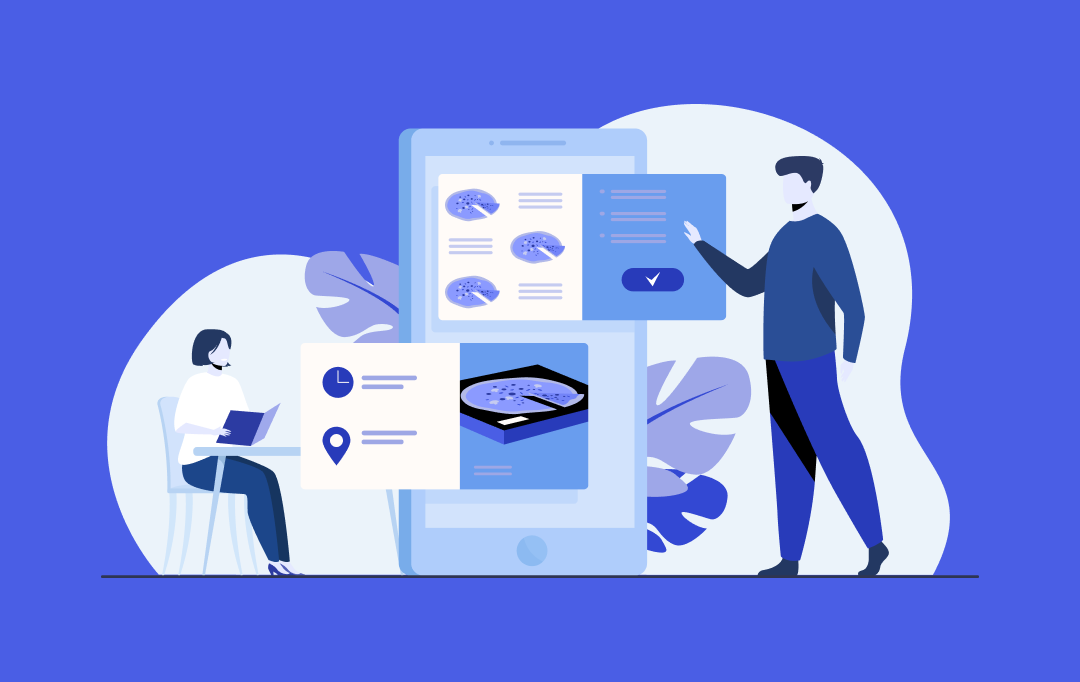
How to Build a Custom Restaurant Management Software? Features, Process, Costs
Key takeaways: Custom restaurant management software turns scattered tools into one operational backbone. The real ROI comes from reduced waste, better staffing, and faster decisions, not just “going digital.” Restaurants use these systems daily for menu control, inventory, workforce planning, and loyalty, not just reporting. Features only work when they match real workflows for guests,…
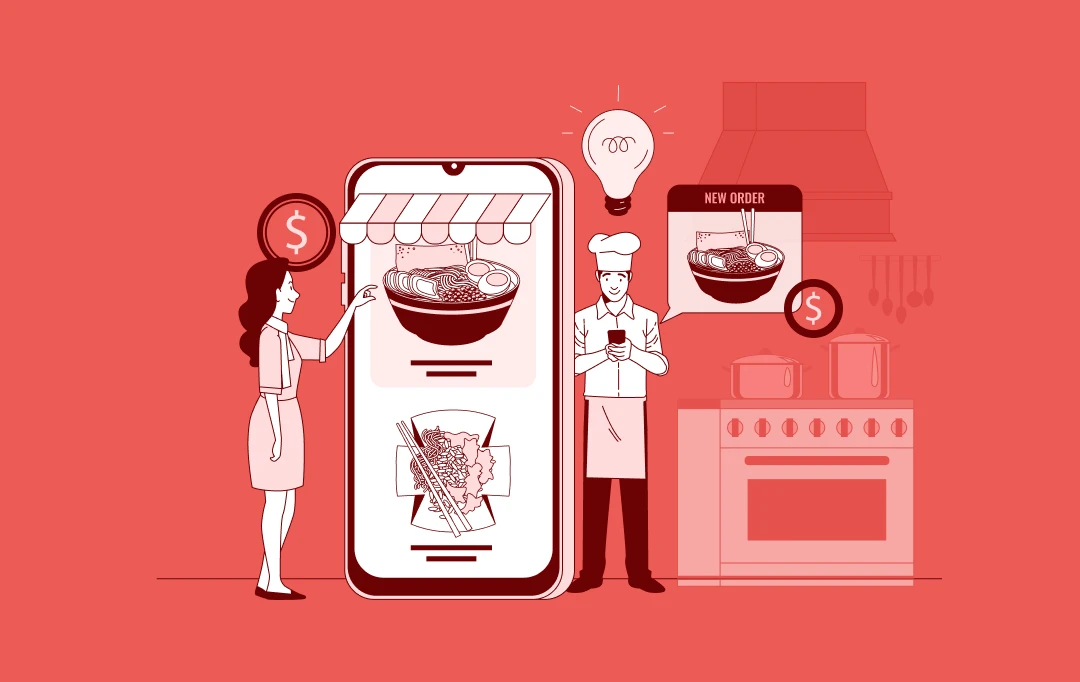
10 Innovative Restaurant Business Ideas That Are Disrupting the Industry
Key takeaways: The success of modern restaurants depends on the adoption of top advanced technologies like AI, AR, IoT, and others, which can simplify operations and increase profitability. Emerging ideas like cloud kitchen, food trucks, and immersive experiences will suit changing consumer needs of convenience, customization, and sustainability. The correct technology infrastructure, a good business…

How Much Does It Cost to Build a Restaurant Reservation App Like OpenTable?
The global food service market’s gonna hit a whopping $4.43 trillion by 2028, with a crazy growth rate of 9.9% from 2021 to 2028. That’s all the reason you need to give your restaurant biz a serious kickstart with a killer restaurant reservation app. (Statista) The biggest problem for diners is that they must manage…
